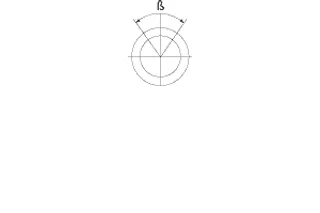Change Language :
Surface speed of iglidur materials
Surface speed
With plain bearings, it is always the circumferential speed that matters. It is not the absolute speed that is decisive, but the relative speed between the shaft and the bearing.
The surface speed is expressed in metres per second [m/s] and is calculated from the speed n [UPM] using the following formula.
Rotations: v = n d1 π/(60 * 1000) [m/s]
Pivoting movements: v = d1 π 2*β/360 * f/1000 [m/s]
whereby

In varying speeds, like it happens in pivoting motions for example, the average surface speed v is standard (see the above-mentioned formula).
d1
Bearing inner diameter [mm]
f
Frequency [s]
β
Angle [°]
n
Revolutions per minute
Permissible surface speeds
iglidur plain bearings have been developed for low to medium surface speeds in continuous operation.
Tables 01 and 02 show the permissible surface speeds of the iglidur plain bearings for rotating, pivoting and linear movements.
These surface speeds are limit values under the assumption of minimum pressure loads on the bearing.
In practice, these limit values can often not be achieved due to reciprocal effects of influences. Any increase in the compressive force inevitably leads to a reduction in the permissible surface speeds and vice versa.
The speed limit is set by the bearing heating. This is also the reason why different surface speeds result for different types of movement.
With linear movements, more heat can be dissipated via the shaft, as the bearing utilises a longer area on the shaft.
Surface speed and wear
Considerations regarding the permissible surface speeds should always include the wear resistance of the plain bearings. High surface speeds automatically result in correspondingly high sliding paths. This means that not only the wear rate increases with the surface speed, but also the total absolute wear.
Surface speed and coefficient of friction
In practice, the coefficient of friction of plain bearings depends on the surface speed. High surface speeds result in a higher coefficient of friction than low speeds. Diagram 01 illustrates this relationship using the example of a steel shaft (Cf53) at a load of 0.7MPa.
Table 01: Maximum recommended surface speeds (long-term) of iglidur plain bearing in m/s
| Material | Rotating | Oscillating | linear |
|---|---|---|---|
| Standards | |||
| iglidur® G | 1 | 0.7 | 4 |
| iglidur® J | 1.5 | 1.1 | 8 |
| iglidur® M250 | 0.8 | 0.6 | 2.5 |
| iglidur® W300 | 1 | 0.7 | 4 |
| iglidur® X | 1.5 | 1.1 | 5 |
| General purpose | |||
| iglidur® K | 1 | 0.7 | 3 |
| iglidur® P | 1 | 0.7 | 3 |
| iglidur® GLW | 0.8 | 0.6 | 2.5 |
| Endurance runner | |||
| iglidur® J260 | 1 | 0.7 | 3 |
| iglidur® J3 | 1.5 | 1.1 | 8 |
| iglidur® J350 | 1.3 | 1 | 4 |
| iglidur® L250 | 1 | 0.7 | 2 |
| iglidur® R | 0.8 | 0.6 | 3.5 |
| iglidur® D | 1.5 | 1.1 | 8 |
| iglidur® J200 | 1 | 0.7 | 10 |
| High temperatures | |||
| iglidur® V400 | 0.9 | 0.6 | 2 |
| iglidur® X6 | 1.5 | 1.1 | 5.4 |
| iglidur® Z | 1.5 | 1.1 | 5 |
| iglidur® UW500 | 0.8 | 0.6 | 2 |
| High media resistance | |||
| iglidur® H | 1 | 0.7 | 3 |
| iglidur® H1 | 2 | 1.0 | 5 |
| iglidur® H370 | 1.2 | 0.8 | 4 |
| iglidur® H2 | 0.9 | 0.6 | 2.5 |
| Contact with food | |||
| iglidur® A180 | 0.8 | 0.6 | 3.5 |
| iglidur® A200 | 0.8 | 0.6 | 2 |
| iglidur® A350 | 1 | 0.8 | 2.5 |
| iglidur® A500 | 0.6 | 0.4 | 1 |
| iglidur® T220 | 0.4 | 0.3 | 1 |
| Special application areas | |||
| iglidur® F | 0.8 | 0.6 | 3 |
| iglidur® H4 | 1 | 0.7 | 1 |
| iglidur® Q | 1 | 0.7 | 5 |
| iglidur® A290 | 1 | 0.7 | 3 |
| iglidur® UW | 0.5 | 0.4 | 2 |
| iglidur® B | 0.7 | 0.5 | 2 |
| iglidur® C | 1 | 0.7 | 2 |
Table 02: Maximum recommended surface speeds (short-term) of iglidur plain bearings in m/s
| Material | Rotating | Oscillating | linear |
|---|---|---|---|
| Standards | |||
| iglidur® G | 2 | 1.4 | 5 |
| iglidur® J | 3 | 2.1 | 10 |
| iglidur® M250 | 2 | 1.4 | 5 |
| iglidur® W300 | 2.5 | 1.8 | 6 |
| iglidur® X | 3.5 | 2.5 | 10 |
| General purpose | |||
| iglidur® K | 2 | 1.4 | 4 |
| iglidur® P | 1.4 | 4 | |
| iglidur® GLW | 1 | 0.7 | 3 |
| Endurance runner | |||
| iglidur® J260 | 2 | 1.4 | 4 |
| iglidur® J3 | 3 | 2.1 | 10 |
| iglidur® J350 | 2 | 2.3 | 8 |
| iglidur® L250 | 1.5 | 1.1 | 3 |
| iglidur® R | 1.2 | 1 | 5 |
| iglidur® D | 3 | 2.1 | 10 |
| iglidur® J200 | 1.5 | 1.1 | 15 |
| High temperatures | |||
| iglidur® V400 | 1.3 | 0.9 | 3 |
| iglidur® X6 | 3.5 | 2.5 | 10 |
| iglidur® Z | 3.5 | 2.5 | 6 |
| iglidur® UW500 | 1.5 | 1.1 | 3 |
| High media resistance | |||
| iglidur® H | 1.5 | 1.1 | 4 |
| iglidur® H1 | 2.5 | 1.5 | 7 |
| iglidur® H370 | 1.5 | 1.1 | 5 |
| iglidur® H2 | 1 | 0.7 | 3 |
| Contact with food | |||
| iglidur® A180 | 1.2 | 1 | 5 |
| iglidur® A200 | 1.5 | 1.1 | 3 |
| iglidur® A350 | 1.2 | 0.9 | 3 |
| iglidur® A500 | 1 | 0.7 | 2 |
| iglidur® A290 | 2 | 1.4 | 4 |
| iglidur® T220 | 1 | 0.7 | 2 |
| Special application areas | |||
| iglidur® F | 1.5 | 1.1 | 5 |
| iglidur® H4 | 1.5 | 1.1 | 2 |
| iglidur® Q | 2 | 1.4 | 6 |
| iglidur® UW | 1.5 | 1.1 | 3 |
| iglidur® B | 1 | 0.7 | 3 |
| iglidur® C | 1.5 | 1.1 | 3 |
Tested in the test laboratory for use in the real world
All materials and products are tested for wear and resilience under real conditions in the igus test laboratory, the largest in the industry. This allows their service life to be precisely determined.
igus also carries out customer tests upon request in order to test the use of the products under completely individualised conditions.
Consulting
I look forward to answering your questions

Shipping and consultation
In person:
Monday to Friday from 7 am - 8 pm.
Saturdays from 8 am- 12 pm.
Online:
24h
WhatsApp-Service:
Montag – Freitag: 8 – 16 Uhr